7.1 Flat roofs and balconies
Appendix 7.1-A
Commonly used flat roofs
Three types of flat roof are shown here to illustrate the principles of their design:
| WARM ROOF (insulation on top of deck) | ||
| concrete deck | timber deck | profiled metal deck |
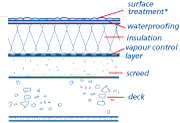 |
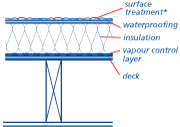 |
 |
| * mineral surfaced or solar reflective treatment where required | ||
| INVERTED WARM ROOF (insulation on top of waterproofing) |
| concrete deck |
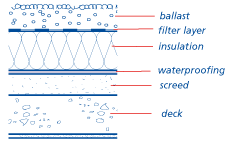 |
| GREEN ROOF | |
| intensive (requires regular maintenance. Plants contained within soil) | extensive (requires periodic maintenance. Plants generally contained in the sedum blanket |
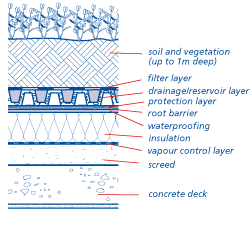 |
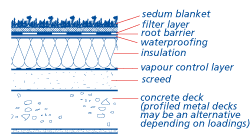 |
WARM ROOF (concrete deck)
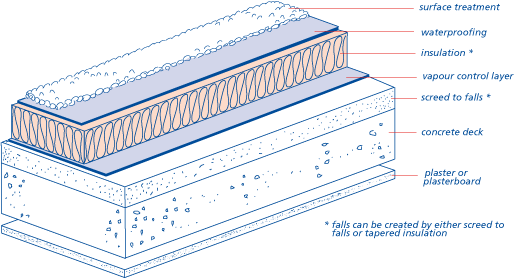
Surface treatment
See Appendix 7.1-B
Waterproofing and insulation
Waterproofing should be one of the following:
- reinforced bitumen membrane (RBM) to BS 747 (or BS 8747 when published) from the following table:
| Type of Reinforced Bitumen Membrane (RBM) | Insulation material | Method of fixing first layer | ||
| First/preparatory layer | Second layer/underlay | Final layer/cap sheet | ||
| Type 3G perforated layer | Type 5U | Type 5E/250, or type 5B/250 plus solar finish | Rigid Urethane Foam (RUF) boards (polyurethane (PU) and polyisocyanurate (PIR) | Loose laid and lapped, to produce partial bonding. |
| Type 3G perforated layer | Elastomeric underlay (polyester-reinforced) | Elastomeric capsheet (polyester-reinforced) | ||
| Type 5U (polyester-reinforced), fully bonded | Type 5U | Type 5E/250, or type 5B/250 plus solar finish | Compressed cork, rock fibre or glass fibre boards, cellular glass slabs, perlite boards, or composite products | Full bitumen bonding, per BS 8217 |
| Type 5U (polyester-reinforced), fully bonded | Elastomeric underlay (polyester-reinforced) | Elastomeric capsheet (polyester-reinforced) | ||
| Note: torching onto insulation boards, except rock/glass fibre or perlite is not acceptable. Note: Elastomeric (i.e. SBS polymer-modified) bitumen membranes, with greater extensibility and flexibility, especially at low temperatures, are likely to provide longer service life. |
||||
- mastic asphalt (BS 6925), 20mm thick on the flat, laid in two layers onto sheathing felt (BS 747 Type 4)
- a thermoplastic single ply membrane, assessed in accordance with Technical Requirement R3, either bonded to the insulation, mechanically fixed to the deck through the insulation, or loose-laid, sealed and ballasted. Refer to the manufacturer's instructions for details.
Vapour control layer
The vapour control layer should consist of at least one layer of bitumen roofing membrane (Type 5U) fully bonded to the structural deck and all laps sealed with bitumen.
Concrete deck and screed
Concrete roof deck, suitably primed, with sand/cement screed topping to achieve the falls. The screed should be in accordance with Clause 7.1-S7(a).
Detailing
Typical details are shown in Appendix 7.1-C.
WARM ROOF (timber deck)

WARM ROOF (profiled metal deck)
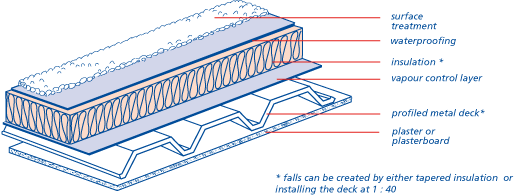
Surface treatment
See Appendix 7.1-B
Waterproofing and insulation
Waterproofing should be one of the following:
- reinforced bitumen membranes (roofing felt) to BS 747 (or BS 8747 when published) from the following table:
| Type of Reinforced Bitumen Membrane (RBM) | Insulation material | Method of fixing first layer | ||
| First/preparatory layer | Second layer/underlay | Final layer/cap sheet | ||
| Type 3G perforated layer | Type 5U | Type 5E/250, or type 5B/250 plus solar finish | Rigid Urethane Foam (RUF) boards (polyurethane (PU) and polyisocyanurate (PIR) | Loose laid and lapped, to produce partial bonding |
| Type 3G perforated layer | Elastomeric underlay (polyester-reinforced) | Elastomeric capsheet (polyester-reinforced) | ||
| Type 5U (polyester-reinforced), fully bonded | Type 5U | Type 5E/250, or type 5B/250 plus solar finish | Compressed cork, rock fibre or glass fibre boards, cellular glass slabs, perlite boards, or composite products | Full bitumen bonding, per BS 8217 |
| Type 5U (polyester-reinforced), fully bonded | Elastomeric underlay (polyester-reinforced) | Elastomeric capsheet (polyester-reinforced) | ||
| Note: torching onto insulation boards, except rock/glass fibre or perlite is not acceptable. Note: Elastomeric (i.e. SBS polymer-modified) bitumen membranes, with greater extensibility and flexibility, especially at low temperatures, are likely to provide longer service life. |
||||
- mastic asphalt (BS 6925), 20mm thick on the flat, laid in two layers onto sheathing felt (BS 747 Type 4)
- a thermoplastic single ply membrane, assessed in accordance with Technical Requirement R3, either bonded to the insulation, mechanically fixed to the deck through the insulation, or loose-laid, sealed and ballasted. Refer to the manufacturer's instructions for details.
Vapour control layer
In bonded systems the vapour control layer should consist of at least one layer of bitumen roofing membrane (Type 5U) fully bonded or nailed to the structural deck and all laps sealed with bitumen. In mechanically fixed systems the vapour control layer should consist of suitable polyethylene sheet sealed at all laps.
Preservative treatment
All roof timbers, joists, wall plates, blocking, strutting, battens, firrings, noggings to be preservative treated, unless naturally durable. Chapter 2.3 'Timber preservation (natural solid timber)' gives details of preservative treatments.
Deck
Timber or timber-based decks should be one of the following:
| Material | Thickness of deck (mm) | |
| Joist centres (mm) | ||
| 450mm | 600mm | |
| Pre-treated plywood, WBP grade | 15 | 18 |
| Marine plywood, WBP grade | 15 | 18 |
| Oriented Strand board Type OSB3 | 15 | 18 |
| Pre-treated timber planking - tongue and grooved ('close boarded timber') Max. board width 100mm. | 19 | 19 |
Reference should be made to Sitework clause 7.1 - S6 for fixing of the deck to joists.
Joists
For sizes and spacing, reference should be made to appropriate load/span tabales published by TRADA in support of Building Regulations and associated documents.
Detailing
Typical details are shown in Appendix 7.1-C.
INVERTED WARM ROOF(concrete deck)
(NOT suitable for slopes greater than 10°)
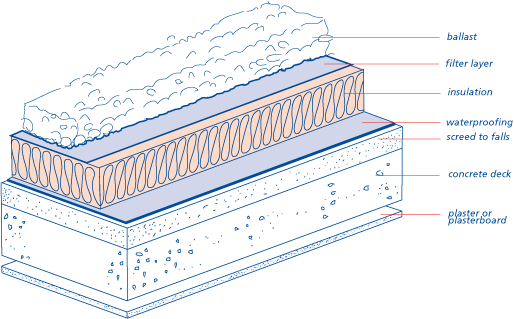
Ballast
Ballast should consist of paving slabs, or of rounded pebbles of minimum diameter 19mm to the depth specified in the design.
Filter layer
Geo-textile layer, laid over insulation boards to prevent fines from reaching the membrane surface.
Insulation
Insulation should be of a type unaffected by exposure to the weather and capable of supporting the weight of the ballast. Only the following materials are suitable:
- extruded polystyrene (XPS)
- extruded polystyrene, with cementitious surface.
Waterproofing
Waterproofing should be one of the following:
- reinforced bitumen membranes (roofing felt) to BS 747 (or BS 8747 when published) from the following table:
| Type of Reinforced Bitumen Membrane (RBM) | Deck material | Method of fixing first layer | ||
| First/preparatory layer | Second layer/underlay | Final layer/cap sheet | ||
| Type 3G perforated layer | Type 5U | Type 5B/250, on flat areas, with type 5E/250 on exposed upstands, etc. | Concrete, or concrete with sand/cement screed | Loose laid and lapped, to produce partial bonding |
| Type 3G perforated layer | Elastomeric underlay (polyester-reinforced) | Elastomeric capsheet (polyester-reinforced) Mineral surfaced on exposed upstands, etc. | ||
| Note: Concrete or screeded substrates should be adequately dry to receive waterproofing system Note: Elastomeric (i.e. SBS polymer-modified) bitumen membranes, with greater extensibility and flexibility, especially at low temperatures, are likely to provide longer service life |
||||
- mastic asphalt (BS 6925), 20mm thick on the flat, laid in two layers onto sheathing felt (BS 747 Type 4).
- a thermoplastic single ply membrane, assessed in accordance with Technical Requirement R3, either bonded or mechanically fixed to the deck, or loose-laid, sealed and ballasted. Refer to manufacturer's instructions for details.
Concrete deck and screed
Concrete roof deck, suitably primed, with sand/cement screed topping to achieve the falls. The screed should be in accordance with Clause 7.1-S7(a).
Detailing
Typical details are shown in Appendix 7.1-C.
Note:
Inverted roofs should only be used with timber (solid or I-joist) or metal profiled decks if they have been designed to support the loads, particularly from the depth of ballast needed to retain the insulation material.
Green Roof
A green roof, either intensive or extensive, should be a complete system from the membrane manufacturer and not individual components or materials. The details given below are intended to be a guide and may vary depending on the individual manufacturers system.
The following identifies the two types of green roof:
Intensive Green Roof
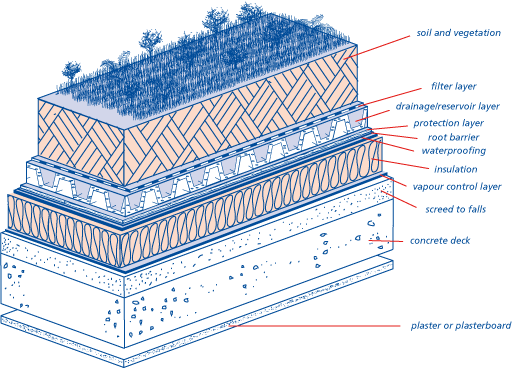
| Feature |
requires regular “intensive” maintenance e.g. similar to a normal garden provides a normal garden environment uses natural topsoil at least 150mm deep and normal plants |
| Structure |
roof design to allow for full weight of wet soil 20° maximum roof pitch |
| Falls and moisture control |
drainage falls 1:60min irrigation system may be required to support plants in dry spells |
| Vapour control layer |
Fully bonded polyester-reinforced RBM (Type 5U) |
| Insulation |
Insulation material to have adequate compressive strength to withstand likely applied loads Where the insulation is above the weatherproofing, only extruded polystyrene (XPS) should be used |
| Waterproofing | See separate table. A root resistant element such as a copper foil or “Preventol” treatment is required above the waterproofing membrane |
| Protection and filter layers |
A filter layer and protection layer (or board), above the waterproofing membrane, is required to prevent damage. These to be in accordance with the manufacturer’s recommendations |
| Type of Reinforced Bitumen Membrane (RBM) |
Insulation Material |
Method of fixing first layer |
||
| First/ preparatory layer |
Second layer/ underlay |
Final layer/ cap sheet |
||
| Type 3G perforated layer |
Type 5U | Type 5B/250, on flat areas, with type 5E/250 on exposed upstands, etc. |
Rigid Urethane Foam (RUF) boards (polyurethane (PU) and polyisocyanurate (PIR)) |
Loose laid and lapped, to produce partial bonding. |
| Type 3G perforated layer |
Elastomeric underlay (polyester-reinforced) |
Elastomeric capsheet (polyester-reinforced) Mineral surfaced on exposed upstands, etc. |
||
| Type 5U (polyester-reinforced), fully bonded |
Type 5U | Type 5B/250, on flat areas, with type 5E/250 on exposed upstands, etc. |
Compressed cork, rock fibre or glass fibre boards, cellular glass slabs, perlite boards, or composite products |
Full bitumen bonding, per BS 8217 |
| Type 5U (polyester-reinforced), fully bonded |
Elastomeric underlay (polyester-reinforced) |
Elastomeric capsheet (polyester-reinforced) Mineral surfaced on exposed upstands, etc. |
||
| Note: torching onto insulation boards, except rockwool or perlite is not acceptable. Note: Elastomeric (i.e. SBS polymer-modified) bitumen membranes, with greater extensibility and flexibility, especially at low temperatures, are likely to provide longer service life. |
||||
| Mastic Asphalt Mastic asphalt to BS 6925 Type 988 T25. Three coat horizontally (30mm total thickness), two coat vertically (20mm total thickness). |
||||
Extensive Green Roof
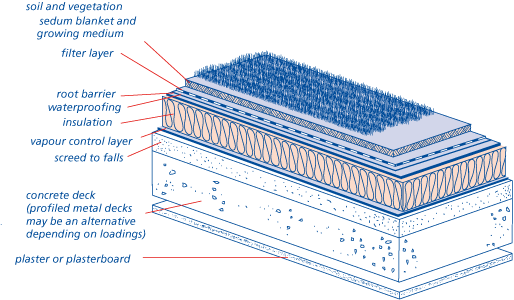
| Features |
requires minimal maintenance e.g. annual attention
a sedum blanket contains the plants |
| Structure | roof loadings less than Intensive roof |
| Falls and moisture control |
45° maximum roof pitch
|
| Vapour control layer |
Fully bonded polyester-reinforced RBM (Type 5U) |
| Insulation | Insulation material to have adequate compressive strength to withstand likely applied loads Where the insulation is above the weatherproofing, only extruded polystyrene (XPS) should be used |
| Waterproofing | See separate table. A root resistant element such as a copper foil or “Preventol” treatment is required above the waterproofing membrane |
| Protection and filter layers |
A filter layer and protection layer (or board), above the waterproofing membrane, is required to prevent damage. These to be in accordance with the manufacturer’s recommendations |
Appendix 7.1-B
Surface treatments
| Maintenance only for roofs up to 10° | Access roof, walkway or terrace deck | Further information may be obtained from | |
| Reinforced Bitumen Membranes (RBM) |
|
|
Flat Roofing Alliance http://www.fra.org.uk/ |
| Mastic Asphalt |
|
|
Mastic Asphalt Council http://www.masticasphaltcouncil.co.uk/ |
| Thermoplastic Single Ply Membranes |
|
|
Single Ply Roofing Association http://www.spra.co.uk/ |
Notes
- Loose surface finishes should be prevented from being removed by weather and discharged into gutters and drain pipes. Chippings should be not less than 12.5mm limestone or white spar, not pea gravel.
- Cement/sand blinding should be laid on two layers of waterproof building paper or two layers of 1000 gauge polyethylene separating membrane. The slabs should be kept back 75mm at perimeters and a 25mm movement gap incorporated for every 9m2 of paving laid.
- Timber decking systems should only use compatible preservative treatments. The undersides of the bearers should have large, smooth contact areas, with no sharp edges or corners.
Appendix 7.1-C
Construction details for flat roofs and balconies
This Appendix contains common details for flat roofs and balconies. The following sketches show examples of typical common construction details and illustrate general principles. Further information on specific waterproofing systems may be obtained from BS 8217 'Reinforced bitumen membranes for roofing - Code of Practice', the Flat Roofing Association, Mastic Asphalt Council or Single Ply Roofing Association.
CONCRETE DECK
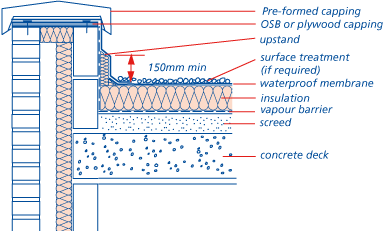
Upstand
- upstand may be fixed to wall
- upstand to be at least 150mm high
- similar details apply to inverted roofs with concrete decks
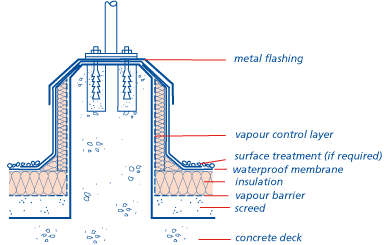
Handrail fixing
- upstand should be formed in concrete roofs
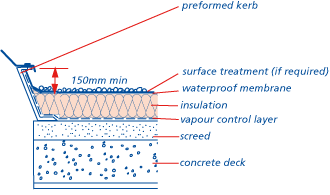
Skirting to rooflight or ventilator kerb
- similar details apply to inverted roofs. Allow for thickness of ballast to achieve upstand dimension.
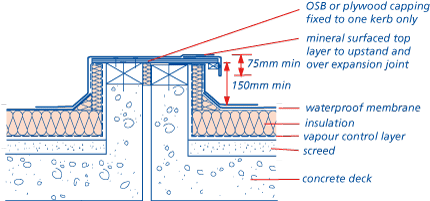
Twin-kerb expansion joint
- expansion joint is similar for both warm and inverted concrete roofs.
TIMBER DECK
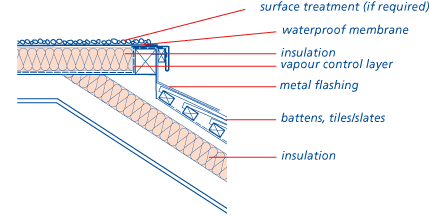
Mansard edge
- All elements should be firmly fixed to prevent peelback in high winds
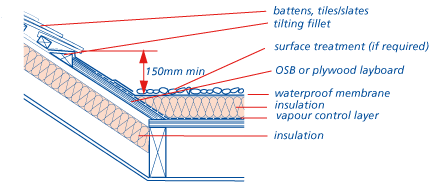
Pitched roof abutment
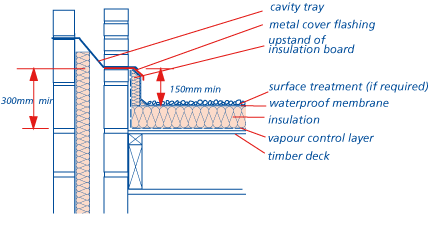
Independent skirting detail
- upstands should be kept separate from wall - allow for movement
- upstand should be at least 150mm high
- similar details apply to cold deck timber roofs

Verge detail
- similar details apply to inverted deck
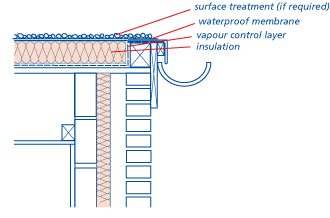
Welted drip to external gutter
- similar details apply to cold deck timber roofs
- inverted timber decks need special consideration to avoid insulation being lifted by wind suction. An alternative detail should be used.
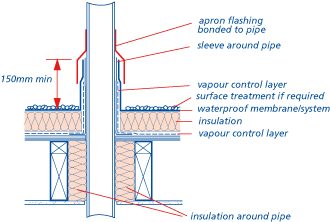
Pipe passing through roof
- vapour control layer should be bonded to waterproofing
- detailing of upstand and flashing is similar for all roofs
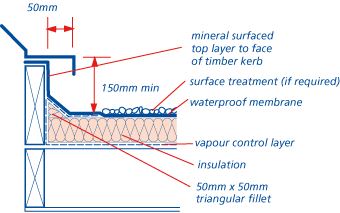
Upstand to ventilator or rooflight kerb
- similar details apply to cold and inverted roofs. The thickness of ballast in inverted roofs, to achieve upstand dimensions, should be allowed for.
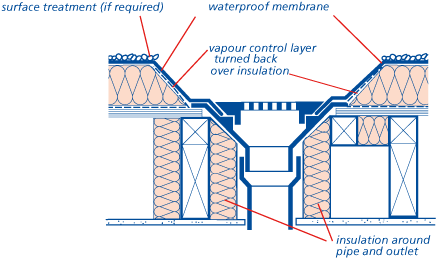
Rainwater outlet
- the opening should be properly trimmed
- the outlet should be at the lowest point in roof
- similar details apply to concrete roof
- ensure outlet is fixed securely to decking to prevent displacement by thermal expansion of rainwater pipe.





















